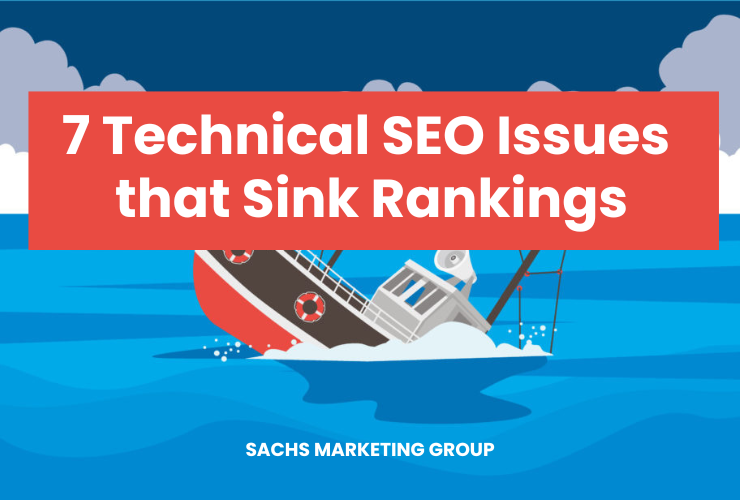The technical health of your website can profoundly impact your rankings and traffic. Here are seven technical SEO issues to know.
There’s more to good search engine optimization (SEO) than clean copy and getting your backlinks sorted. No matter how much effort you put into improving your organic SEO and building up your traffic if your website isn’t up to the technical tasks that search engines like Google expect it to perform, you might heavily stunt your growth and waste your time.
Technical SEO can be difficult. While many CMS platforms like WordPress try to keep things as simple and efficient as possible, you can’t expect everything to work out of the box. And some of the challenges of technical SEO only become apparent over time – as you build up a larger sitemap, more and more permalinks, and a greater host of potential backlinks.
Keeping an eye on your website’s technical SEO can be the difference between ranking high on the search engine results pages and not ranking at all.
Here are some of the most common technical SEO issues that sink rankings.
If you want my team at Sachs Marketing Group to help you with your technical SEO issues, click here.
Overview
Defining Technical SEO (And Technical SEO Issues)
Technical SEO refers to the mechanics of your website and how it performs when people visit. Is it slow to load? Is it secure to visit? Is mobile-friendly?
While it’s important to create a digital content strategy, find the best keywords, and attract high-quality backlinks, it’s also important to improve the technical SEO of your website.
Today, we’re focusing on the following technical SEO issues – many of which are common SEO mistakes.
- Page layout
- Page loading speeds
- SSL certification
- Visitor usability
- Mobile compatibility
- Sitemaps
- Optimized meta descriptions
The best places to discover these issues are Google Search Console, Semrush, and ahrefs.
Sufficient technical know-how is needed to optimize your website properly. That means knowing how to deal with server errors, why your website might need SSL encryption if you have a login function or any password inputs, image compression in HTML5, and how to disavow unwanted backlinks.
Many websites fail to prioritize technical SEO, which destroys keyword rankings, website traffic, and visibility around your products, services, and brand. For this reason, you must prioritize your website’s technical SEO health. This will ensure your website passes Google’s various tests that help determine how your content is (or isn’t) indexed.
If you ignore technical issues, there’s no point in optimizing your traffic or dialing in on what kind of audience you’re drawing to your web pages. if a potential lead’s first impression of your content is a sluggish and uninviting mess. It doesn’t matter if you fix that over time; people will remember your site and avoid it. Let’s examine some of the most common problems killing your site today.
[smgquote author=”Chris Rice, Senior SEO Strategist”]
Nurturing the health of your technical SEO is just as important as keyword research, content development, and backlink development.
[/smgquote]
If you want to ensure your website is healthy, be sure to partner with an SEO company that offers technical SEO services. In most cases, SEO services include technical SEO.
1. Duplicated Links and Content
Is your content unintentionally spread thin? Depending on how you have your website set up, you may be unintentionally indexing multiple different permalinks with the same content.
If you have a single page with about three or four different yet similar URLs, then search engines like Google may treat these as separate web pages, spreading your traffic thin. Furthermore, duplicate content – even on your own page – can spell disaster for your rankings.
Thankfully, there are a few ways to identify and remedy the problem. Some webmaster tools, like Google Webmaster, even have an automated function to avoid duplicate content
While duplicate content may not be a penalty any more in Google’s eyes, it still creates confusion. It may negatively impact the capability of your web page content to rank effectively.
2. Nonindexed Content
Nonindexed or “noindex” content is anything search engines like Google or Bing haven’t added to their search results. You can think of it as content that might still be up on your website but is cut off from being found online.
And suppose you successfully eliminate all links to it. In that case, it’s impossible to find without looking through an outdated sitemap (don’t keep nonindexed content on your sitemap!) or entering the correct URL.
Sometimes, nonindexed content includes content that search engines haven’t crawled yet. Sometimes, it includes content you want search engines to crawl, but for some reason – usually a quality or security issue – it isn’t being picked up. And sometimes, you can explicitly tag web pages as nonindexed if you want to slowly remove them from your website.
If you have pages that search engines haven’t indexed yet, then don’t dawdle – find out why.
3. Using Old AJAX Iframes
Iframes or inline frames are separate instances of a website being loaded inside another website. Think of it as a window added to your page that loads its own URL. While they used to have a use, these are largely outdated in modern HTML and won’t favor your search rankings.
Search engines don’t recognize the content being loaded inside of the page, and it won’t count towards the page’s total content, which can be frustrating if the rest of the page is relatively bare-bones and not worth ranking. Furthermore, these iframes can be resource-intensive for your page and any browsing devices, which means slower loading speeds. Speed is key.
[smgquote author=”Eric Sachs, CEO”]
Anything that takes more than three or four seconds to load is too slow.
[/smgquote]
Related: Factors That Affect Website Speed
4. Using Adobe Flash
Let’s face it, Flash is dead. Not only will anything that still tries to use Flash fail to load, but it’s retired from all modern browsers worth mentioning. Replace any and all Flash files on your website if you haven’t already!
5. Lacking Mobile Optimization
The majority of internet users browse the web on their phones. Mobile traffic took over web traffic a few years ago, and the ratio continues to grow.
If you haven’t optimized your website with a specific focus on mobile usability, you will be severely hurting your page at this point. Most website themes and templates are developed with mobile responsiveness, but it’s always good to check. Use Google’s mobile-friendly test to determine if your website is mobile-friendly.
6. Broken Links
As a website grows and its content begins to age, some of the links you may be linking to in blog posts, articles, news releases, and product descriptions may die. As you might imagine, broken links are less useful and less liked by search engines.
Thankfully, there are multiple different tools that you can use to crawl your own web pages and identify broken links that are going nowhere.
7. Unidentified Server and Page Errors
Error 404? Error 500? Error 403? Error 503? Websites throw up different errors depending on what’s plaguing them, and depending on the error in question, not dealing with them (as a webmaster) can severely penalize your content.
These error codes work because each corresponds to a different problem, as per the format dictated by the Internet Engineering Task Force. Each of these errors results from a miscommunication or issue between your browser, the server hosting the content, and the content itself.
Codes that start with Error 4xx are usually client-side, meaning something is wrong with the content on the page (for example, it’s missing). Codes that start with Error 5xx are server-side, meaning something is wrong with the server the content is hosted on (for example, something is preventing the request from being fulfilled). These errors aren’t just problems for potential visitors but also affect search engine crawlers.
Pay close attention to technical errors, and fix them quickly.
[smgquote author=”Chris Rice, SEO Manager”]
Investing in SEO can provide valuable organic traffic month after month, year after year.
[/smgquote]
Conclusion
Technical SEO is a treasure trove of issues and problems. On a positive note, it means that there are always ways for you to improve your website and stay ahead of the competition. On a negative note, it means the work is never really done – not when engines like Google continue to update and make changes to the way they crawl the web daily.
Ensure your technical SEO is up to snuff by working with an experienced SEO team, rather than trying to take it on yourself – and distracting yourself from other important issues.
What technical SEO issues are struggling with currently? I’d love to hear how things are going in the comments section below.
Contact us today to get the conversation started!










